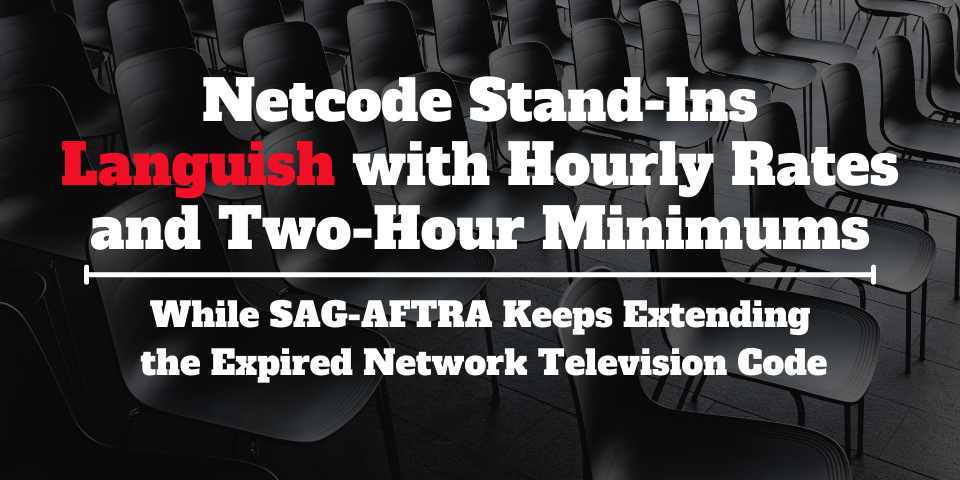About a year ago, SAG-AFTRA called Wages & Working Conditions meetings around the expiring Network Television Code (“Netcode”) (found here and here). This contract, which is basically an old AFTRA contract, covers live television, shows with a studio audience (game shows, award shows, etc.), promos, and daytime television, among other productions.
TV stand-ins working on a Netcode job have starkly different wages and working conditions than when they work under SAG-AFTRA’s Television Agreement or even in movies under the Theatrical Agreement. While under those contracts most stand-ins currently make $214 as their daily rate (eight hours), under the Netcode the take-homes are less — sometimes dramatically less.
For example, Netcode stand-ins may work at an hourly rate, rather than a daily rate. At that, stand-ins may have as little as a two-hour minimum under the Netcode. A current rate for stand-ins under the Netcode is $29/hour — so with a two-hour minimum, a union stand-in working under the Netcode can report to work and take home as little as $58 for the day.
Before the Netcode was to expire on June 30th of last year, SAG-AFTRA announced the extension of the Netcode by four months, putting its new expiration around the end of October (roughly October 31st).
On October 26th, SAG-AFTRA reached an agreement with the industry to extend the Netcode again to January 21st, 2022.
That was not the last extension of the Netcode on which SAG-AFTRA signed off. Around the time the Netcode was to expire again, SAG-AFTRA (in coordination with its negotiating committee) reached another agreement with the industry to extend the Netcode to expire on March 18th, 2022.
Then, around March 18th’s expiry, SAG-AFTRA’s negotiating committee agreed to extend the Netcode again. On March 18th, it was still finalizing the new expiration date, but it has since been confirmed as May 5th, 2022.
What the Netcode Extensions Mean
The Netcode was due to expire on June 30th, 2021. SAG-AFTRA had caucused its membership to contribute bargaining proposals and ideas for those negotiations in the preceding winter and spring. SAG-AFTRA then went on to agreeing to four extensions of the Netcode rather than demanding negotiations with Netcode employers.
As a result of these extensions, wages and working conditions that were set to expire last year are kept at status quo. This means that rather than, say, a predictable wage increase happening to SAG-AFTRA unit members working under the Netcode from July 1, 2021, onward, SAG-AFTRA put off those predicted wage increases. Effectively, SAG-AFTRA unit members working under the Netcode are working at expired, depressed, discounted wages.
It also means that Netcode employers got to keep paying what effectively are depressed or discounted wages for SAG-AFTRA talent after June 30th, 2021, and they are currently producing at wages that predictably would have expired. In other words, production minimum costs for talent did not go up as might have been expected, so these contract extensions effectively underwrite production costs. Put differently, producers can produce more cheaply than they expected because the Netcode has not yet been renegotiated.
When SAG-AFTRA and (as the union likes to vaguely call it:) “the industry” finally sit down to renegotiate the Netcode, presumptively SAG-AFTRA will be working with a bargaining package influenced by W&W meetings from a year or more ago. In other words, SAG-AFTRA may be negotiating with old ideas, or — put differently — may be negotiating without new ideas from members, influenced by work since the last W&Ws over a year ago.
Of note, there is no agreement with Netcode producers in place similar to the Return To Work Agreement. This means that if a SAG-AFTRA unit member works during the pandemic for a Netcode producer, there is no union-negotiated, guaranteed minimum compensation for pre-employment testing, health assessment surveys, etc. While SAG-AFTRA says it asks Netcode producers to follow the Return To Work Agreement, Netcode producers are largely not signed to it, so any grievances a SAG-AFTRA unit member may have around a Netcode producer’s pandemic-related conduct may not be grievable.
What the Netcode Extensions Mean … to Stand-Ins
At $29/hour with a two-hour minimum, many Netcode stand-ins suffer from working for what appears to be the smallest take-home pay in SAG-AFTRA’s entire unit.
Many stand-ins hired to work under the Netcode don’t actually know they’re working under a different contract, thinking simply “they are working as a stand-in” and thus expecting their stand-in work and working conditions to be the same when they typically stand in (say, under the Television or Theatrical Agreements).
When learning they have a two-hour minimum, their expectations of at least a paycheck of $214 are dashed when they leave with $58 to their name.
Stand-In Central has long promoted the poor union wages many stand-ins under the Netcode suffer. Despite our efforts, SAG-AFTRA members ratified the current agreement back in 2018, maintaining the two-hour minimum many stand-ins experience.
Netcode Predictions
Under an eventual proposed successor to the Netcode, Stand-In Central does not predict an elimination of hourly wages for stand-ins under the Netcode, or an elimination of the hour minimums some Netcode stand-ins face.
As a general prediction, whatever SAG-AFTRA negotiates as a successor agreement to the Netcode will be ratified by SAG-AFTRA members. Members will not as a majority refuse to ratify a proposed successor simply because stand-in wages are not transformed. Instead, whatever SAG-AFTRA tells its members to vote, members will largely vote. (In other words, if SAG-AFTRA tells its members to “Vote Yes!” on a proposed agreement, a simple majority of members will do so, ratifying the proposed agreement.) Most members won’t even really understand what the Netcode is and will not have worked under it.
Stand-In Central predicts in an eventual proposed successor a wage increase for stand-ins to $30/hour, lasting perhaps for two years, with hourly minimums preserved.
While some SAG-AFTRA contracts provide for retroactive wage increases (for wages paid between expiration of the contract and ratification of the new one), Stand-In Central does not expect any retroactive application of a wage increase for any wages paid after July 1st, 2021, mostly because SAG-AFTRA agreed to extend the past agreement (multiple times). However, retroactive wage increases are still a possibility (but unlikely given how much time has passed since the Netcode’s original expiry).
Final Thoughts
The topic of Netcode stand-in rates is dear to Stand-In Central. The editor has long worked under the Netcode and is familiar with the surprise stand-ins have when learning their two-hour minimum for professional work. The editor also knows how obscure this large SAG-AFTRA contract is for most SAG-AFTRA unit members, making it hard to drum up interest in the plights of Netcode stand-ins to obtain better take-home pay.
So, if you care to share this article, please do so using the icons below this post.
If SAG-AFTRA eventually sends you a ballot to vote on a proposed Netcode successor agreement, scrutinize the improvements for stand-ins. Notably, look to see if they will still be paid hourly. If so, consider voting No on the contract referendum. Your No vote would help send more messages to SAG-AFTRA that they need to do better for Netcode stand-ins.
Have you stood in on a Netcode job? What was your pay like? Where you surprised to learn about your pay? Share your perspectives in the comments below!







Leave A Comment